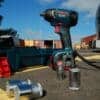
The EPA reports that with around four people living in a home, water as much as 400 gallons per day is getting used. But the same number of people when using water sparingly can be using advanced plumbing in the homes. That can save over 30,000 gallons of water every year.
That is enough water to quench the thirst of 150 people. A home’s plumbing scheme will not only influence the use of water. They will affect the amount of energy used up too.
That is because 15% of the energy getting used goes to heating water. Water pouring out of the shower with great pressure and hitting you hard when you are not yet alert is annoying.
You can solve all these issues with innovative plumbing concepts. There is a way of improving a home piping system to use as little energy as possible while heating water. At the same time, little water will go to waste.
You can upgrade the plumbing supply system. That is by using residential plumbing blueprints incorporating advanced plumbing technology.
Many issues happen with plumbing. More so while trying to merge the home piping system with the home systems. When the home’s design is being put together.
It doesn’t happen when picking and installing materials. Yet, we cannot downplay how important it is to have the right plumbing materials.
There is no need to panic if you discover that your home’s piping system is not performing as expected. Getting optimal service is possible. You can do that by adding innovative plumbing concepts that can boost the current system.
It is possible to get out of the traditional plumbing system. You can do that by using new technology that comes with exclusive features and abilities. The plumbing systems are different, but the advanced technology is the same.
Table of Contents
Advanced plumbing concepts
Make the plumbing stack central to stop pipe runs.
That will also make it easy to remodel or repair the plumbing system without the need to spend much money. You can enjoy credit services if the home you are putting up is LEED-certified.
The ‘PATH Design Guide has the perfect examples of plumbing systems. The plumbing is in a central system.
Another option is the home-run plumbing supply system. You can use it to come up with control centers.
These systems use fewer materials and less water. They make the systems last longer being flexible for remodeling.
Installing them is simple compared to the standard systems. You should add the modular quick connectors and fixtures.
The plumbing schemes will become efficient and adaptable. This was not there before in the plumbing industry.
Putting up a home-run piping system will cost you as much as installing a rigid pipe system. But, the process of installation may take longer. Because contractors might need training if they have never built the system before.
For energy-efficient plumbing, install a water heater that doesn’t need the use of a tank. There is a lot of energy lost while the hot water stays idle in the tank.
The energy lost could be anything between 20 to 60 percent of the yearly costs you will pay for heating water.
Doing away with such huge losses is possible. Start using a tankless water heater. It is also called an instant water heater.
The instant water heater is costly. It costs as much as a high-efficiency water heater model that has a tank.
Installing an instant water heating system is pricey. You pay two to four times more than the usual cost of installing a regular water heater.
The extra cost comes from the needs that arise from the extra processes. One is the use of more electricity. The other is the need for different pipe sizes for use in the process.
A cheaper alternative would be a solar-powered water heating system. For this, you need to install solar panels.
Install facilities that save on water. The first low-flow toilets got a better version.
It is a dual flush low-flow toilet. There is no need for flushing it twice like the first version which made it less popular with consumers.
Conserve graywater for reuse
Graywater is water that has already been in use. It is from dishwashers, washing machines, sinks, shower drains, and bathtubs. This kind of water makes 60% of the water used in a home.
Graywater is recycled dirty water. It can be used for wash areas outside the home as well as for toilet water and irrigation.
The systems used to trap graywater are simple if you include them when constructing a home. It is difficult to improvise after building the home.
In the beginning, the cost of directing gray water to the treatment area is very low. It is not the same as the cost of treating toilet water, which is also called black water.
Thus, the maintenance cost is high. It covers regular testing and treatment of the graywater system.
It also includes the effects of time. It takes time for code officials to become experienced in handling the system.
Use air-admittance valves (AAVs)
AAVs are mechanical vents. They prevent pressure from building up in the pipes after a toilet flush. By using them, there is no need of installing the usual venting pipes that penetrate the roof.
The AAVs get activated when pressure builds up in the pipe. When flushing the toilet the wastewater goes down the pipe with air. The air results in pressure which triggers the valve to open.
The opening will balance out the pressure and waste will drain. The valve closes when the pressure balances.
That makes it easy for air to get into the piping system when needed. At the same time, it makes sure bad odor cannot get into the house.
When fixing an AVV use a push-fit joint. A push-fit joint makes it possible to fit sockets and pipes together without using any tools.
Installing AAVs will result in reduced costs. The materials needed during plumbing will be fewer.
There will be more options for fixture layout. Also, the number of roof penetrations will reduce. Maintenance will not need much either.
You can get an AAV for the price of anything between 25 to 40 dollars. The cost of installing the valve is minimal.
Install a garbage disposal unit under the kitchen sink
A garbage disposal unit is also called a garburator. It is usually powered by electricity. It is set between the trap under the kitchen sink and the drain pipe.
It reduces food waste into tiny bits by shredding it. That way, the food waste can go down the pipes.
A guide to good plumbing practices
The most efficient plumbing systems go with good everyday plumbing practices. These are the things every homeowner should know. Consumers can relax without having to call in the plumber every time a plumbing problem comes up.
Where are the shut-off valves?
This is a question that all homeowners should have an answer to. When you move into a new house, you have to know where the shut-off valves are. Plus, you have to know where the drain is too.
In some homes, the main shut-off valve is outside the main house. Further, knowing where the access points for the sewer lines are is important. It will help when you have to do cleanouts.
But, for condos and apartments, it is different. There may be sharing of shut-off valves between condos or apartments.
Avoid puncturing pipes
Are you into DIY home improvement projects? Do you hammer nails into ceilings, walls, or floors? If you do, first find out whether there are drainage or supply pipes behind those surfaces.
You will avoid puncturing the pipes. While at the same time avoiding unwanted expenses.
An affordable stud finder will help you find the pipes behind the surfaces you will be working on. You can also buy an endoscopic camera. You use it by snaking it into the walls.
What do you flush and what don’t you flush down the toilet?
The toilet should never be a replacement for a trash can. It is only for human waste and toilet paper. Anything else can clog the toilet’s plumbing system.
To avoid unnecessary expenses and labor, do not flush anything else down the toilet. Even baby wipes labeled as flushable are not worth the risk of getting the loo clogged.
Avoid putting garbage in the kitchen pipe drains
It is easy to clog the kitchen drain as well. There are things you should never pour into the sink.
These are bits of food left on the plate, coffee grounds, veggie peelings, and bacon grease. They will clog the drain.
Starches like bits of rice and potatoes will clog the kitchen drain too. Do not get the dishes into the sink without clearing them of bits of food. They will block the system.
It is important to read the manufacturer’s manual. Read it when installing a garbage disposal unit. That is how to know what is okay to put through the unit and what is not.
Buy the best plunger in the market to help clear clogs in the plumbing system
When buying a plunger, go for the highest quality plunger you can find in the market. It gets rid of clogs that form in drains, sinks, as well as toilets.
Before cleaning sink traps, remove the water by using a plunger, then, remove the trap. The chore will be messier otherwise.
Avoid clogs by using a basket strainer
Clogs are difficult to avoid altogether. But by using a basket strainer, you can prevent soap residue and hair from clogging your shower drain.
Your sink drain could use a strainer too. Unclogging the drain is an unpleasant chore that is avoidable. It saves time.
Use a vacuum to dislodge clogs
Sometimes small hard objects like combs, toothbrushes, or children’s toys clog a drain. in such cases, use a vacuum that is wet-dry to dislodge the objects.
It is better to suck out the object than use a plunger. A plunger could make it harder to remove the object as it could push it further into the drain.
Take care of leaks when you discover them
When you find a leak, like a dripping valve, try to fix it immediately. A delay to wastes water and the water bill goes up.
A leaky faucet may waste the likes of ten gallons of water every day. A toilet that is running, that needs fixing, may waste up to 200 gallons of water every day.
Repair and stop the leaks without waiting too long to do it. The more you delay, the bigger and costlier the problem will become.
Test to find out whether the seal for the toilet’s flush valve is leaking using food color.
To be sure the seal for the toilet’s flush valve is okay, put a few drops of food color in the toilet’s water tank. Wait for a few hours.
If the water in the toilet’s bowl colors, you’ll know there is a leak. You can then get the leak fixed.
Tighten fittings to the point you feel they have tightened right by hand. Because one mistake is always overlooked. When taking care of plumbing, people make connections and fittings too tight.
By and by that results in screws stripping, and bolts breaking. A comfortable tightening is when you do it by hand.
Use a plumber’s tape (Teflon tape) for sealing pipe threads
The best way to prevent leaks around fittings and joints is by using a plumber’s tape. Start by wrapping the tape around and sealing the pipe threads.
Use the white tape for household plumbing tasks. The yellow tape is usually for connections in gas lines.
Look for leaks after finishing a plumbing project
After fixing a pipe system, run water through it to see if there are leaks. Even trained plumbers may miss a tiny leak. In that case, the connection needs resealing.
Conclusion
After getting advanced plumbing and drain into your home. You need to maintain it with the above DIY tips. That is how to get the most out of the new plumbing system.


